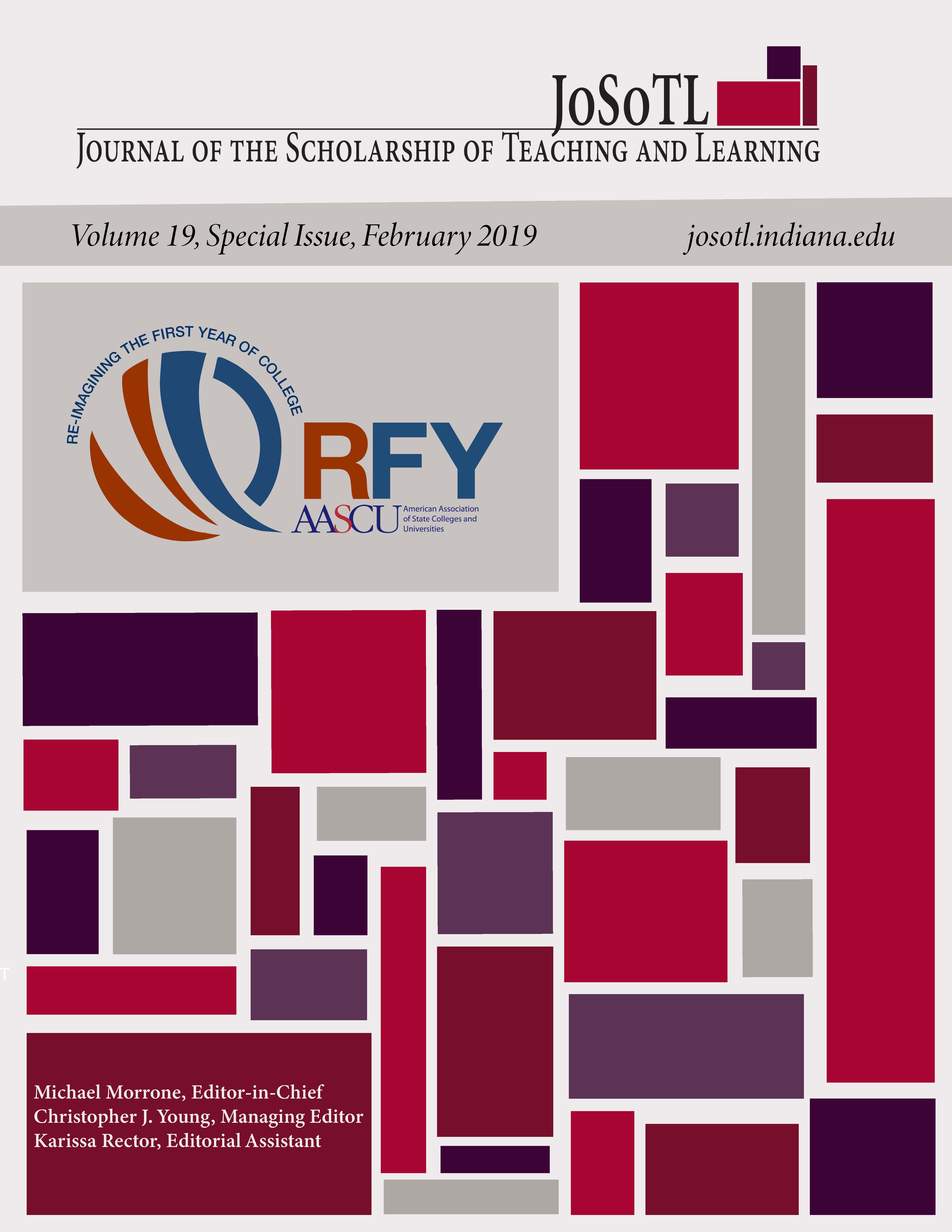Students’ Sense of Belonging: The Development of a Predictive Retention Model
Main Article Content
Abstract
Educational institutions increasingly recognize the role that student belonging plays in retention. Many studies in this area focus on helping students improve a sense of belonging before they matriculate or identifying belonging as a reason for their departure. This study measures students’ sense of belonging at key transition points during the first year and finds that social belonging and academic performance are both strong predictors of retention that are not necessarily correlated. These results suggest that a comprehensive, focused outreach protocol that encompasses both social and academic factors could have a positive impact on student persistence.
Downloads
Article Details
- Authors retain copyright and grant the Journal of the Scholarship of Teaching and Learning (JoSoTL) right of first publication with the work simultaneously licensed under a Creative Commons Attribution License, (CC-BY) 4.0 International, allowing others to share the work with proper acknowledgement and citation of the work's authorship and initial publication in the Journal of the Scholarship of Teaching and Learning.
- Authors are able to enter separate, additional contractual agreements for the non-exclusive distribution of the journal's published version of the work (e.g., post it to an institutional repository or publish it in a book), with an acknowledgement of its initial publication in the Journal of the Scholarship of Teaching and Learning.
- In pursuit of manuscripts of the highest quality, multiple opportunities for mentoring, and greater reach and citation of JoSoTL publications, JoSoTL encourages authors to share their drafts to seek feedback from relevant communities unless the manuscript is already under review or in the publication queue after being accepted. In other words, to be eligible for publication in JoSoTL, manuscripts should not be shared publicly (e.g., online), while under review (after being initially submitted, or after being revised and resubmitted for reconsideration), or upon notice of acceptance and before publication. Once published, authors are strongly encouraged to share the published version widely, with an acknowledgement of its initial publication in the Journal of the Scholarship of Teaching and Learning.
References
Berger, J. & Braxton, J. (1998). Revising Tinto’s interactionalist theory of student departure through theory elaboration: Examining the role of organizational attributes in the persistence process. Research in Higher Education, 39 (2), 103-119.
Dweck, C. S. (2008) Mindset: the new psychology of success. New York: Ballantine Books.
Hoffman, M., Richmond, J., Morrow, J., & Salomone, K. (2002). Investigating sense of belonging in first year college students. Journal of College Student Retention, 4 (3), 227-256.
Hurtado, S., & Carter, D. F. (1997). Effects of college transition and perceptions of the campus racial climate on Latino college students’ sense of belonging. Sociology of Education, 70, 324-345.
Jorgenson, D. A., Farrell, L. C., Fudge, J. L., & Pritchard, A. (2018). College connectedness: The student perspective. Journal of the Scholarship of Teaching and Learning 18 (1), 75-95.
Kember, D., & Leung, D. Y. P. (2004). Relationship between the employment of coping mechanisms and a sense of belonging for part-time students. Educational Psychology, 24 (3), 345-357.
Krumrei-Mancuso, E., Newton, F., Kim, E. & Wilcox, D. (2013). Psychosocial factors predicting firstyear college student success. Journal of College Student Development, 54 (3), 247-266.
Lane, T. B. (2016). Beyond academic and social Integration: Understanding the impact of a STEM enrichment program on the retention and degree attainment of underrepresented students. CBE-Life Sciences Education 15, 1-13.
Lee, R. M., & Davis, C. (2000). Cultural orientation, past multicultural experience and a sense of belonging on campus for Asian American college students. Journal of College Student Development, 41 (1), 110-115.
Levitz, R., & Noel, L. (1989). Connecting students to institutions: Keys to retention and success. In M. L. Upcraft, J. N. Gardner, & Associates (Eds.), The freshman year experience (pp. 65-81). San Francisco, CA: Jossey-Bass Publishers.
Steele, C. (1997). A threat in the air. American Psychologist 52 (6), 613-629.
Steele, C. and Aronson, J. (1995). Stereotype threat and the intellectual test performance of African Americans. Journal of Personality and Social Psychology 69 (5), 797-811.
Stephens, N. M., Hamedani, M. G., & Destin, M. (2014). Closing the social-class achievement gap: A difference-education intervention improves first-generation students’ academic performance and all students’ college transition. Psychological Science, 25, 943-953.
Tinto, V. (1975). Dropout from higher education: A theoretical synthesis of recent research. Review of Educational Research, 45 (1), 89-125.
Tinto, V. (1993). Leaving college: Rethinking the causes and cures of student attrition (2nd ed.). Chicago: University of Chicago Press.
Tinto, V. (1997). Colleges as communities: Exploring the educational character of student persistence. Journal of Higher Education, 68 (6), 599-623.
Tinto, V. (1998). Colleges as communities: Taking research on student persistence seriously. The Review of Higher Education, 21 (2), 167-177.
Walton, G. M., & Cohen, G. L. (2007). A question of belonging: race, social fit, and achievement. Journal of Personality and Social Psychology, 92, 82-96.
Walton, G. M., & Cohen, G. L. (2011). A brief social-belonging intervention improves academic and health outcomes of minority students. Science, 331, 1447-1451.
Woosley, S. A. (2003). How important are the first few weeks of college? The long-term effects of initial college experiences. College Student Journal 37 (2), 201-207.
Woosley, S. A. & Miller, A. L. (2009). Integration and institutional commitment as predictors of college student transition: Are third week indicators significant? College Student Journal 43 (4), 12601271.
Woosley, S. A. & Shepler, D. K. (2011). Understanding the early integration of first-generation college students. College Student Journal 45 (4), 700-714
Yeager, D. S. & Walton, G. M. (2011). Social-psychological interventions in education: They’re not magic. Review of Educational Research, 81, 267-301.
Yeager, D., Walton, G., Brady, S., Akcinar, E., et al. (2016). Teaching a lay theory before college narrows achievement gaps at scale. Proceedings of the National Academy of Science, 113 (24), E33413348.
Zea, M. C., Reisen, C. A., Beil, C., & Caplan, R. D. (1997). Predicting intention to remain in college among ethnic minority and nonminority students. Journal of Social Psychology, 137, 149-160.
